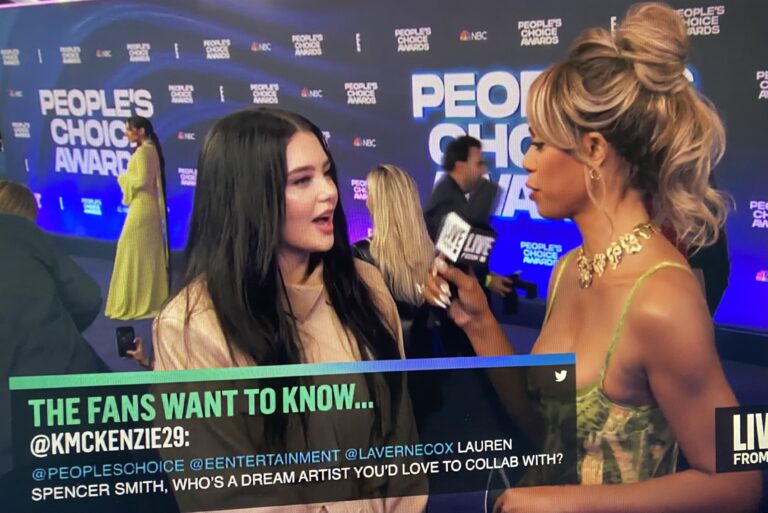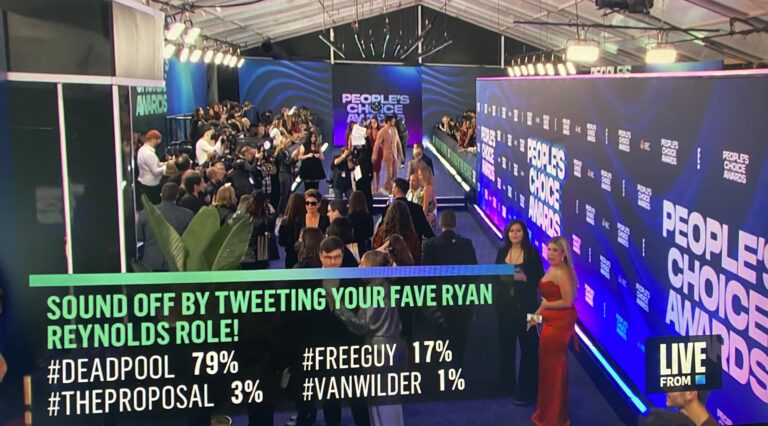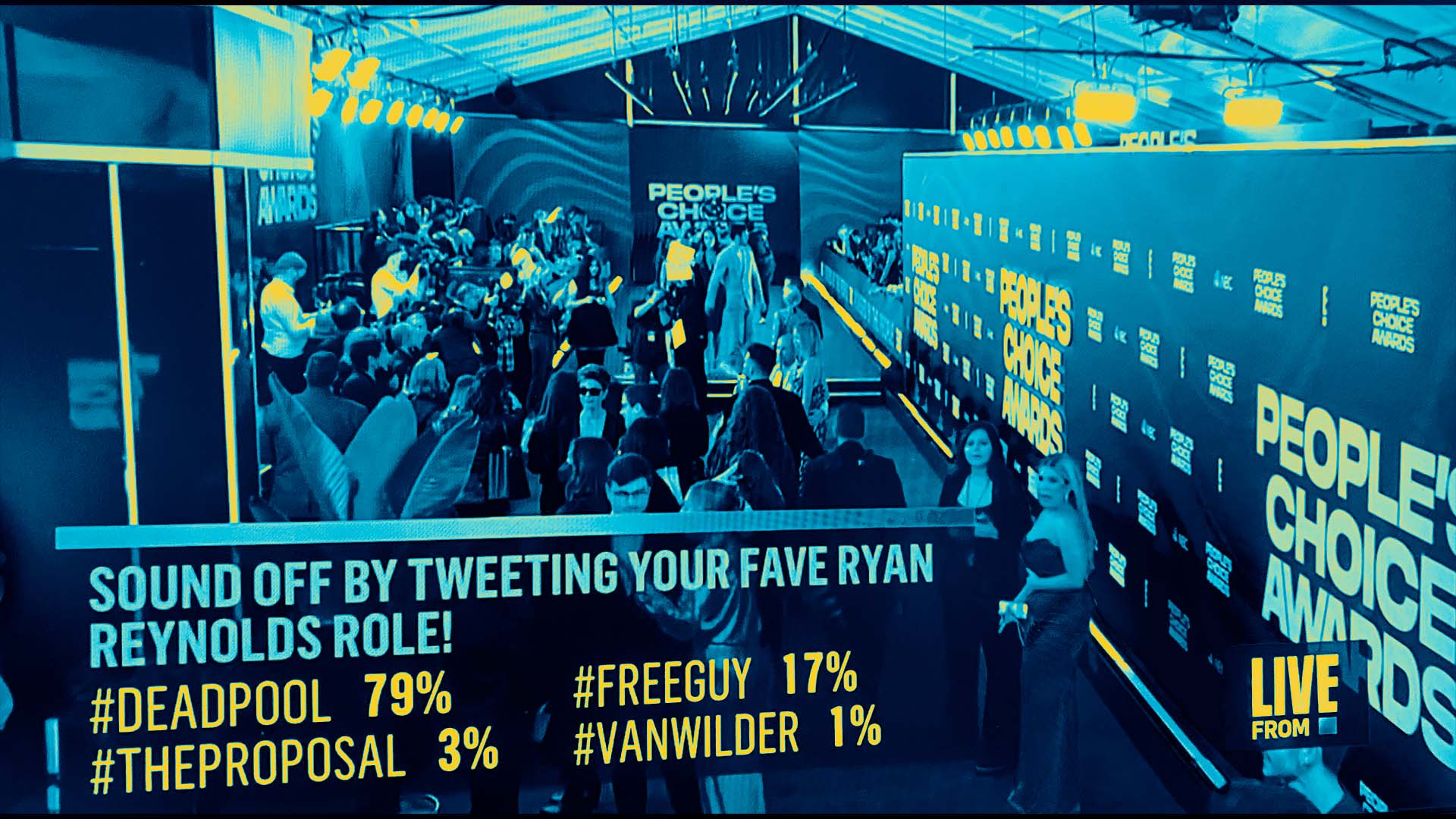Red Carpet: Who are you wearing? It’s a question synonymous with red carpet broadcasts. A little friendly gesture on behalf of the reporter/host which allows the celebrity a chance to shout out their designer. It’s a familiar exchange, but like fashion, broadcasters are looking to start a new trend. Producers are finding new ways to dress up their red carpet coverage and take their audience beyond the designer shoutout.
Award shows are remembered for their moments. A bold outfit, a red carpet crash or a front row selfie. Nowadays those moments aren’t restricted to when the camera’s are rolling; not during this social media renaissance. In this day and age you can capture show moments through social, by bringing the voice of your viewers into the broadcast, or leaning on celebrity social channels as a new camera source.
Connecting fans with celebrities
The People’s Choice Awards is for the people and by the people, so E! Entertainment made sure to make the people a part of the production. An easy win on any red carpet is allowing your audience to ask questions directly to their favorite celebrities. Not only does it make someone’s day, but it often is a question the celebrity hasn’t heard before and tends to elicit a unique response.

Another way we see productions add interactivity, and capture their audiences attention, is through engaging polls. These polls can have a direct impact on the editorial direction of the production, or they can be a way to capture the pulse of the viewing audience. Either way they add a little flare to the broadcast and capture the attention of a distracted viewing audience.

Red carpet social peek behind the scenes
On show day, celebrities spend all day getting ready for their red carpet moment and, thanks to social media, they’re giving us a peek inside the process, posting everything leading up to and including the limo ride. Award shows have taken notice and are now leveraging those moments to add a new angle to their red carpet interviews. At this past Oscars, Ryan Seacrest was interview Melissa McCarthy live on the red carpet for E! Entertainment. During that interview Seacrest referenced a special moment to start McCarthy’s day, a homemade breakfast that McCarthy’s husband, Ben Falcone, shared on social media.
As Seacrest asked the question, the director called out asking if we had the post. A couple clicks later, in a fast paced and smooth workflow, E! was able to bring the post onscreen within seconds of the question being asked. The moment garnered a big pay off for the viewer being able to visualize Seacrest’s reference, and an organic reaction to seeing the post on screen from McCarthy.
Fans crave content that makes them feel more connected to the celebrities they follow. Content that humanizes the people we sometimes idolize, like showing the hours of prep work it takes to walk out of a limo camera ready. At the Met Gala, E! was able to highlight the different ways celebrities get ready using Instagram stories. From Serena Williams playing tennis before donning a gown, to Chrissy Teigen running late and sharing it with her fans.
When the Red Carpet heats up, it gets crazy in the control room. Chasing down video of all the different arrivals, grabbing interviews and making sure you don’t miss a moment. It’s easy in the fray to forget about the social content, or to only highlight fan reaction. Looking at another Met Gala moment, E! found unique ways to break up the crazy flow in a meaningful way. Either showing a celebrity getting ready and then fading to them on the red carpet for the finished product, or showing a red carpet look and then leveraging a post from Constance Wu of an up close look at the detail in her fingernails. The cameras on the red carpet capture a lot, but celebrities cell phones are capturing new angles.
The social doesn’t stop when the red carpet show ends. Main show and after shows also offer plenty of opportunities to inject new perspectives into the broadcast. Telemundo showed off a fancy look at Latin Billboards in Las Vegas. They were pushing a watch party hashtag before and during the show, asking for their viewers reactions to every major moment from the night. To push the call-to-action they bumped to break using a look that resembled a Las Vegas slot machine featuring some of the best looks of the night. It was a good example of making every moment in the show meaningful, and breaking away from the classic pre-recorded city time lapse or blimp shot of the strip.
These moments all happened in award shows, but the ideas aren’t exclusive to those events. The look Telemundo pulled off as they bumped to break could easily be photos of college graduates at a college commencement ceremony. Or similar to celebrities taking us into their dressing rooms, athletes can show their fans a sneak peek into the pregame locker room. Coaches give motivational pregame speeches, players put little sayings or motivational messages on their gear, showing an up close look at these moments on the big screen to an already buzzing crowd would only amplify the pregame energy.
Whether it’s at an award show on the red carpet or a game day around the stadium, social media gives us a unique behind-the-scenes view into how everything comes together in the end, and it humanizes celebrities who are involved. By leveraging that content, producers can tell the true story of the show or game and enhance the overall broadcast experience.
